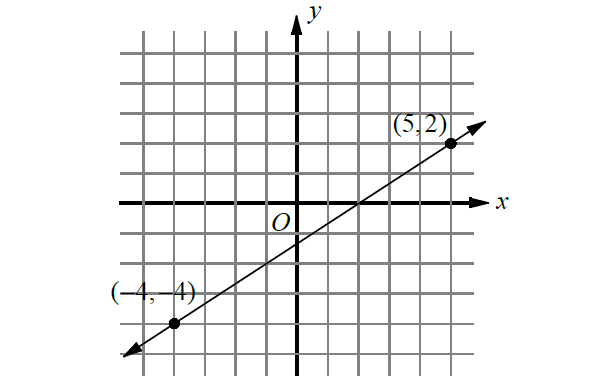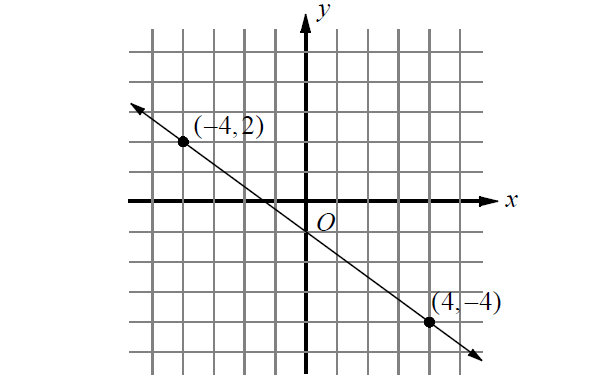SAT MATH - SLOPE INTERCEPT FORM AND POINT SLOPE FORM
Subscribe to our ▶️ YouTube channel 🔴 for the latest videos, updates, and tips.
The slope-intercept form equation of a line :
y = mx + b
m ----> slope
b ----> y-intercept
The point-slope form equation of a line :
y - y1 = m(x - x1)
m ----> slope
(x1, y1) ----> point
Solved Problems
Problem 1 :
The graph of a linear equation is shown on the diagram below.

(a) Find the slope of the line on the graph.
(b) Write the equation of the line in slope-intercept form.
(c) Write the equation of the line in point-slope form using the point (5, 2).
Solution :
Part (a) :
Formula to find the slope of a line joining two points :
Substitute (x1, y1) = (-4, -4) and (x2, y2) = (5, 2).
Part (b) :
Slope-intercept form equation of a line :
y = mx + b
Substitute m = ⅔.
y = (⅔)x + b
To find the value of b, substitute one of the points on the line into the equation.
Substitute (x, y) = (5, 2).
2 = (⅔)(5) + b
2 = ¹⁰⁄₃ + b
2 - ¹⁰⁄₃ = b
-⁴⁄₃ = b
Therefore, slope-intercept form equation of the given line :
y = (⅔)x - ⁴⁄₃
Part (c) :
Point-slope form equation of a line :
y - y1 = m(x - x1)
Substitute m = ⅔ and (x1, y1) = (5, 2).
y - 2 = (⅔)(x - 5)
Problems 2-4 : Refer to the following information.

The graph of a linear equation is shown on the diagram below.
Problem 2 :
Which of the following is the equation of the line in point-slope form?
(A) y + 4 = (-⁴⁄₃)(x - 4)
(B) y - 4 = (-⁴⁄₃)(x + 4)
(C) y - 2 = (-¾)(x + 4)
(D) y + 2 = (-¾)(x - 4)
Solution :
Formula to find the slope of a line joining two points :
Substitute (x1, y1) = (-4, 2) and (x2, y2) = (4, -4).
Equation of the line in point-slope form :
y - y1 = m(x - x1)
y - y1 = (-¾)(x - x1)
|
Using the point (-4, 2), y - 2 = (-¾)[x - (-4)] y - 2 = (-¾)(x + 4) |
Using the point (4, -4), y - (-4) = (-¾)(x - 4) y + 4 = (-¾)(x - 4) |
Therefore, the correct answer is option (C).
Problem 3 :
Which of the following is the equation of the line in slope-intercept form?
(A) y = (-¾)x + 1
(B) y = (-¾)x - 1
(C) y = (-⁴⁄₃)x + 1
(D) y = (-⁴⁄₃)x - 1
Solution :
Equation of a line in slope-intercept form :
y = mx + b
We already know the slope of the line, that is m = -¾.
y = (-¾)x + b
Substitute one of the points on the line to find the value of b.
Substitute (x, y) = (-4, 2).
2 = (-¾)(-4) + b
2 = (-3)(-1) + b
2 = 3 + b
-1 = b
Equation of the given line in slope-intercept form :
y = (-¾)x - 1
Therefore, the correct answer is option (B).
Problem 4 :
Which of the following is the equation of the line in standard form?
(A) 4x - 3y = -4
(B) 4x + 3y = -4
(C) 3x - 4y = -4
(D) 3x + 4y = -4
Solution :
Consider the equation of the line in slope-intercept form found in problem 3 above.
y = (-¾)x - 1
Multiply both sides by 4.
4y = 4[(-¾)x - 1]
4y = 4[(-¾)x] - 4
4y = -3x - 4
Add 3x to both sides.
3x + 4y = -4
Therefore, the correct answer is option (D).
Problem 5 :
Which of the following is the equation of the line that passes through point (4, -1) and has slope -2?
(A) x + 2y - 2 = 0
(B) x - 2y - 6 = 0
(C) 2x - y - 9 = 0
(D) 2x + y - 7 = 0
Solution :
Equation of a line in slope-intercept form :
y = mx + b
Given : Slope m = -2.
y = -2x + b
Substitute (x, y) = (4, -1).
-1 = -2(4) + b
-1 = -8 + b
7 = b
Equation of the given line :
y = -2x + 7
Add 2x to both sides.
2x + y = 7
Subtract 7 from both sides.
2x + y - 7 = 0
Therefore, the correct answer is option (D).
Problem 6 :
A cab service charges a fixed rate of $25 and $2.50 per mile. Write an equation in slope-intercept form that models this situation. Use the equation to find the total cost for a 25-miles trip.
Solution :
Let y be the total cost for travelling x miles.
The equation in slope-intercept form that models this situation is
y = 2.5x + 30
To find the total cost for an 25-miles trip, substitute x = 25 into the above equation.
y = 3(25) + 30
y = 75 + 30
y = 105
The total cost for a 25-miles trip is $105.
Subscribe to our ▶️ YouTube channel 🔴 for the latest videos, updates, and tips.
Kindly mail your feedback to v4formath@gmail.com
We always appreciate your feedback.
©All rights reserved. onlinemath4all.com
Recent Articles
-
SAT Math Practice
Dec 05, 25 04:04 AM
SAT Math Practice - Different Topics - Concept - Formulas - Example problems with step by step explanation -
10 Hard SAT Math Questions (Part - 37)
Dec 03, 25 07:02 AM
10 Hard SAT Math Questions (Part - 37) -
Factorial Problems and Solutions
Dec 02, 25 09:27 AM
Factorial Problems and Solutions

